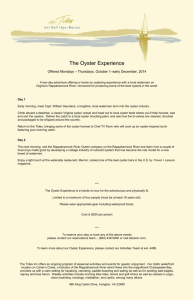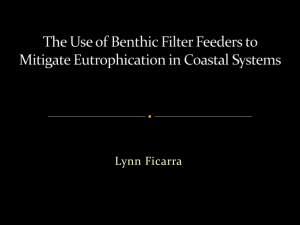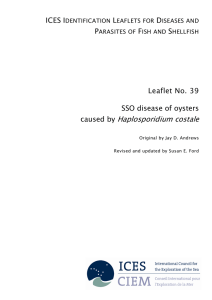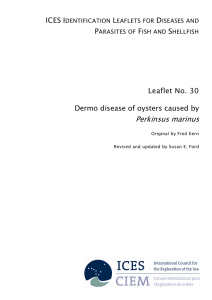Roseovarius crassostreae ICES I L
advertisement
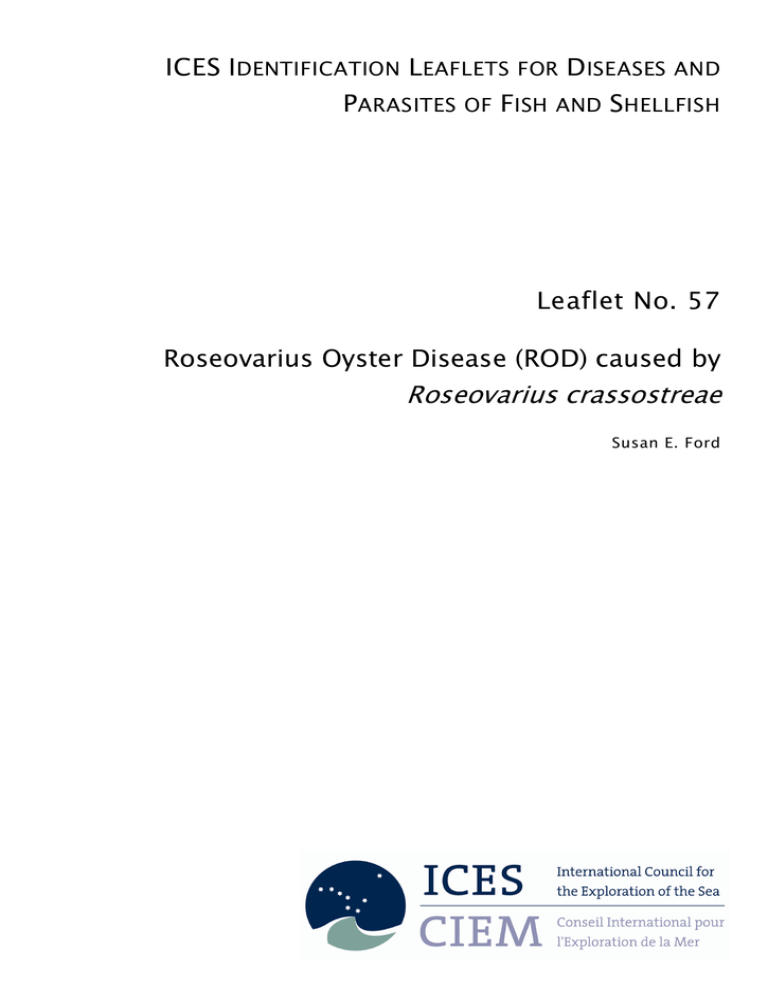
ICES IDENTIFICATION LEAFLETS PARASITES OF FOR FISH DISEASES AND AND SHELLFISH Leaflet No. 57 Roseovarius Oyster Disease (ROD) caused by Roseovarius crassostreae Susan E. Ford International Council for the Exploration of the Sea Conseil International pour l’Exploration de la Mer H.C. Andersens Boulevard 44–46 DK-1553 Copenhagen V Denmark Telephone (+45) 33 38 67 00 Telefax (+45) 33 93 42 15 www.ices.dk info@ices.dk Recommended format for purposes of citation: Ford, S. E. 2011. Roseovarius Oyster Disease (ROD) caused by Roseovarius crassostreae. ICES Identification Leaflets for Diseases and Parasites of Fish and Shellfish. Leaflet No. 57. 4 pp. Series Editor: Stephen Feist. Prepared under the auspices of the ICES Working Group on Pathology and Diseases of Marine Organisms. For permission to reproduce material from this publication, please apply to the General Secretary. ISBN 978-87-7482-099-4 ISSN 0109–2510 © 2011 International Council for the Exploration of the Sea Leaflet No. 57 | 1 Roseovarius Oyster Disease (ROD) caused by Roseovarius crassostreae by Susan E. Ford Susceptible species Eastern oyster, Crassostrea virginica Disease name Roseovarius Oyster Disease (ROD), formerly Juvenile Oyster Disease (JOD) Aetiological agent Roseovarius crassostreae, an alpha-proteobacterium, which is the numerically dominant bacterium isolated from ROD-affected oysters and has been found in all ROD outbreaks so far examined. Challenge with R. crassostreae induces ROD-like conchiolin deposits and the bacteria can be re-isolated from affected individuals. R. crassostreae has also been detected in oysters in concert with the earliest microscopic tissue lesions and the development of gross disease symptoms. Geographical distribution Major outbreaks and associated mortality have been reported in cultured oysters from New York to Maine (USA), with few or no reports from more southern sites. A similar syndrome has been reported in eastern oysters experimentally kept in a French hatchery. Associated environmental conditions ROD outbreaks typically occur in rapidly growing juvenile eastern oysters during their first summer of culture. Onset of disease symptoms occurs when water temperature has exceeded about 21–22°C. Outbreaks have been limited to high salinity (25–32) sites. Experimental transmission was ineffective at salinity and temperature below 18 and 18°C, respectively. The disease seems to be related to a variety of high-density culture conditions (upwellers, trays, bags). Significance Mortalities of up to 90% occur in animals <25 mm; larger juveniles show characteristic inner-shell organic deposits, but have much lower mortalities. For nearly ten years, ROD was a major impediment to hatchery-based oyster culture in the northeastern United States, but the incidence of the disease has diminished significantly since the late 1990s. Gross clinical signs Sharply decreased growth rates often precede the appearance of gross ROD signs. The principal signs include (i) extreme cupping of the lower valve, (ii) breaking off of the growing edge of the upper valve, leaving a band of exposed, fouled, inner shell on the lower valve, and (iii) secretion of a conchiolin layer, on both valves, that surrounds the soft tissues, which retract well into the shell cavity. The conchiolin layer is raised into a ridge at the periphery of the mantle, resulting in the appearance of a distinct “brown ring” on the inner shells of affected oysters. The conchiolin layer Roseovarius Oyster Disease (ROD) caused by Roseovarius crassostreae 2 | frequently disrupts the adductor muscle attachment, causing the soft tissues to fall out of the shell. Oysters that survive an ROD outbreak often have a pronounced growth check visible on both the inner and outer shell. Control measures and legislation Selective breeding has produced oyster strains with significantly better survival than unselected controls. Some of the improvement appears to be due to more rapid growth so that oysters reach the critical 25 mm size before the onset of disease in midsummer. A similar outcome can be achieved by early season production and deployment of juveniles to give them a head start on growth. Decreasing density in trays and bags, increasing mesh size, and increasing flow rate through upwellers have all proven effective in reducing losses. ROD is not an OIE listed disease. Diagnostic methods The disease is typically diagnosed by its shell signs, principally the anomalous conchiolin deposit. The prevalence of the conchiolin deposit is highly correlated with mortality in oysters between about 10 and 25 mm shell height, but smaller oysters in which R. crassostreae is detected may die without the appearance of shell anomalies. Mantle and gill lesions are the principal histopathological correlates with ROD, but cannot be considered specific for the condition. A PCR assay for the detection of R. crassostreae is available based on the 16S-23SrDNA internal transcribed spacer region. The PCR sample should be collected by swabbing the inner shell surface. This method, which can detect as few as ten bacteria, is preferable to tissue sampling, which can reduce the assay’s sensitivity. Key References Barber, B. J., Carnegie, R. B., and Davis, C. V. 1996. Effect of timing of seed deployment on growth and mortality of oysters, Crassostrea virginica, affected by Juvenile Oyster Disease (JOD). Journal of the World Aquaculture Society, 27: 443– 448. Barber, B. J., Davis, C. V., and Crosby, M. A. 1998. Cultured oysters, Crassostrea virginica, genetically selected for fast growth in the Damariscotta River, Maine, are resistant to mortality caused by Juvenile Oyster Disease (JOD). Journal of Shellfish Research, 17: 1171–1175. Boettcher, K. J., Geaghan, K. K., Maloy, A. P., and Barber, B. J. 2005. Roseovarius crassostreae sp. nov., a member of the Roseobacter clade and the apparent cause of juvenile oyster disease (JOD) in cultured Eastern oysters. International Journal of Systematic and Evolutionary Microbiology, 55: 1531–1537. Bricelj, V. M., Ford, S. E., Borrero, F. J., Perkins, F. O., Rivara, G., Hillman, R. E., Elston, R. A., and Chang, J. 1992. Unexplained mortalities of hatchery-reared, juvenile oysters, Crassostrea virginica (Gmelin). Journal of Shellfish Research, 11: 331–347. Lee, M., Taylor, G. T., Bricelj, V. M., Ford, S. E., and Zahn, S. 1996. Evaluation of Vibrio spp. and microplankton blooms as causative agents of Juvenile Oyster Disease in Crassostrea virginica (Gmelin). Journal of Shellfish Research, 15: 319– 329. Lewis, E. J., Farley, C. A., Small, E. B., and Baya, A. M. 1996. A synopsis of juvenile oyster disease (JOD) experimental studies in Crassostrea virginica. Aquatic Living Resources, 9: 169–178. Leaflet No. 57 | 3 Maloy, A. P., Barber, B. J., and Boettcher, K. J. 2005. A PCR-based diagnostic assay for the detection Roseovarius crassostreae in Crassostrea virginica affected by juvenile oyster disease (JOD). Diseases of Aquatic Organisms, 67: 155–162. Maloy, A. P., Barber, B. J., and Boettcher, K. J. 2007. Use of the 16S-23S rDNA internal transcribed spacer of Roseovarius Crassostreae for epizootiological studies of juvenile oyster disease (JOD). Diseases of Aquatic Organisms, 76: 151–161. Maloy, A. P., Ford, S. E., Karney, R., and Boettcher, K. J. 2007. Roseovarius crassostreae, the etiological agent of Juvenile Oyster Disease in Crassostrea virginica. Aquaculture, 269: 71–83. Paillard, C., Ashton-Alcox, K., and Ford, S. E. 1996. Changes in bacterial densities and hemocyte parameters in oysters affected by Juvenile Oyster Disease. Aquatic Living Resources, 9: 145–158. Renault, T., Chollet, B., Cochennec, N., Gerard, A. 2002. Shell disease in American oysters, Crassostrea virginica, reared in France: detection of anomalous calcium deposits in gills and mantle. Journal of Invertebrate Pathology, 79: 1–6. Roseovarius Oyster Disease (ROD) caused by Roseovarius crassostreae 4 | 1 2 * 3 4 Figure 1. Example of uneven shell margins caused by the loss of the fragile growing edge of the upper valve. Figure 2. Example of conchiolin deposits on inner valve, showing fouling outside the raised ridge (arrow). Figure 3. Histological section through mantle edge, showing anomalous conchiolin deposit (arrows) and exudate of hemocytes (*). Figure 4. Severe lesion on mantle surface. Epithelium has been almost completely eroded. A utho r C o nta ct I nfo r ma ti o n Susan E. Ford Rutgers University Haskin Shellfish Research Laboratory Port Norris, New Jersey, 08349 USA susan@hsrl.rutgers.edu





